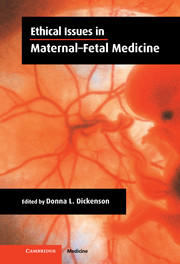Book contents
- Frontmatter
- Contents
- List of contributors
- Acknowledgements
- 1 Introduction: recent debates in maternal–fetal medicine – what are the ethical questions?
- 2 Overview: a framework for reproductive ethics
- I GENERIC ISSUES IN PREGNANCY
- II INCEPTION OF PREGNANCY: NEW REPRODUCTIVE TECHNOLOGIES
- III FIRST AND SECOND TRIMESTER
- IV THIRD TRIMESTER
- V NEONATAL LIFE
- 19 Do new reproductive technologies benefit or harm children?
- 20 Are there lives not worth living? When is it morally wrong to reproduce?
- 21 Ethical issues in withdrawing life-sustaining treatment from handicapped neonates
- Index
19 - Do new reproductive technologies benefit or harm children?
from V - NEONATAL LIFE
Published online by Cambridge University Press: 29 September 2009
- Frontmatter
- Contents
- List of contributors
- Acknowledgements
- 1 Introduction: recent debates in maternal–fetal medicine – what are the ethical questions?
- 2 Overview: a framework for reproductive ethics
- I GENERIC ISSUES IN PREGNANCY
- II INCEPTION OF PREGNANCY: NEW REPRODUCTIVE TECHNOLOGIES
- III FIRST AND SECOND TRIMESTER
- IV THIRD TRIMESTER
- V NEONATAL LIFE
- 19 Do new reproductive technologies benefit or harm children?
- 20 Are there lives not worth living? When is it morally wrong to reproduce?
- 21 Ethical issues in withdrawing life-sustaining treatment from handicapped neonates
- Index
Summary
In the recent ethical and social scientific literature on new reproductive technologies (NRTs) and practices there is not much discussion about their impact on children (e.g. Birke, Himmelweit and Vines, 1990; Iglesias, 1990; Marrs, 1993; Robertson, 1994; Hartouni, 1997; Steinberg, 1997). As the final report of the Canadian Royal Commission on New Reproductive Technologies (Royal Commission on New Reproductive Technologies, 1993: p. 42) puts it,
There is a dearth of information about, for instance, the direct outcomes of being conceived through assisted reproduction. Physical outcomes are important to monitor, but there may also be emotional and psychological outcomes to being born through the use of assisted methods of conception. For instance, we know very little about the effect on a child's sense of identity and belonging of being born through assisted insemination using donor sperm or following in vitro fertilisation using donated eggs.
Books and anthologies written from a feminist perspective mostly emphasize the effects of NRTs on women (e.g. Rowland, 1992; Spallone, 1989). None the less, there is a connection, in reproductive issues, between the status of women and the status of children. This connection is explicitly recognized within the United Nations Declaration of the Rights of the Child (United Nations, 1959), which calls for ‘special care and protection’ both for children and for their mothers, ‘including adequate prenatal and postnatal care’ (Principle 4). Hence, it can plausibly be argued that if NRTs either benefit or harm women, then their children may be comparably affected.
- Type
- Chapter
- Information
- Ethical Issues in Maternal-Fetal Medicine , pp. 305 - 320Publisher: Cambridge University PressPrint publication year: 2002

